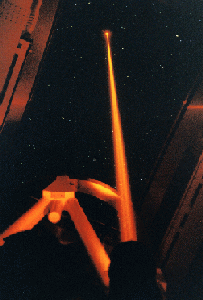
Adaptive optics with a
Laser
For
Astronomy



Adaptive optics with a
Laser
For
Astronomy
Although the Adaptive Optics module for ALFA is still being used for observations at Calar Alto using natural guide stars, the laser has been decomissioned. We are now working on a more powerful, remotely operable version called PARSEC which will be used at the VLT.
| ALFA laser system | ||
|
Results
latest:
previous
|

| system design |
What you see here is 4 W of laser power, enough to produce an artifical guide star in the sodium layer 90 km up that can be used to greatly improve the quality of images by correcting for turbulence in the atmosphere. Low down, the beam appears bright due to the backscatter from gas and dust.
For a list of full results, publications, team members, how to apply for observing time, etc. see the ALFA homepage
Such a powerful laser pointed into the air can, of course, be dangerous for aircraft pilots if they happen accidently to look down the beam. Although they wouldn't be permanently blinded, they would certainly be dazzled. ALIENS is an aircraft detection system, which has been installed to avoid this danger. It is simply an optical camera mounted on the front ring of the telescope, which shuts off the laser when there is a detection of a moving object.
Before acquiring the laser on the WFS it is important that the
telescope is focussed as well as possible, because the height of the
sodium layer (and therefore also the focus position of the WFS) is not
known exactly.
This step is not necessary when using a natural start since the WFS
focus position is always the same; the perfect telescope focus is where
the WFS residual is zero.
A set of automated algorithms have made the task of acquiring the laser
on the wavefront sensor very simple.
First the laser is viewed on the TV-guider, which produces an excellent
picture of the
Rayleigh cone tipped by the LGS
(it also acts as a very sensitive `cloud detector' and any thin layer
of moisture in the atmosphere shows up clearly as a bright ring in the
Rayleigh cone).
Once the LGS is positioned correctly,
the TV-guider is then moved out so the LGS can be seen on the WFS.
The positioning can then be fine-tuned.
Both the launch telescope and WFS focus are adjusted roughly by hand, and
then a pair of automated algorithms obtain the perfect focus positions so
that the spots are as small and bright as possible.
A reference fibre is then moved into the laser focus position (another
automated algorithm finds this position since it is not known in advance -
it depends on the distance to the sodium layer) in the AO
bench and used to calibrate modes on the WFS.
Once calibration is complete, the fibre is moved out and the system is
ready to be used.
The LGS brightness is around 9 mag, although it is rather dependent on zenith angle and Na column density. That is enough for the adaptive optics to make good improvements in image quality.
Until mid 1999 the LGS always appeared very extended on the wavefront sensor, as can be seen in a
WFS image, which
provide a comparison of the laser and a natural guide star.
Movies from March 1998 of the natural guide star (NGS) and laser
guide star (LGS) show the open-loop motion of the spots,
using 2 lenslet arrays (3x3 & 5x5) and sampling frequencies (60 Hz &
100 Hz):
MPEG format:
NGS 3x3 60Hz
LGS 3x3 60Hz
NGS 5x5 100Hz
LGS 5x5 100Hz
A more recent LGS 5x5 array movie from June 99 shows the enormous improvement in the appearance of the LGS. The spots are now much more compact and brighter, resulting in significantly better centroid measurements. To see just how much improvement has been made, it is worth seeing the image taken when we were able to first lock on the LGS in Sept 97. The spot in the centre shows that the system wasn't aligned properly then.
The jitter of the spot pattern is completely due to the atmosphere, the combination of tip-tilt from different upward and downward paths. It can best be seen if the LGS is imaged through a single lens, as this LGS single lenslet movie from May 1999 shows. This is a problem becuase the LGS can move too close to the edge, and even out, of the centroiding regions causing the AO loop to crash.
While it was running, MPE was a partner of the European `Training & Mobility of Researchers' network on Laser Guide Stars for 8-metre class Telescopes, which coordinates the main drive of the European effort in this area. ALFA was involved in a number of experiments pertinent to the use of lasers for adaptive optics, including tilt recovery from a LGS, sodium layer statistics, atmospheric turbulence, light pollution, etc. These experiments and some of the preliminary results are described in more detail on the ALFA TMR page.
The structure and full work of the network is summarised in a paper by Foy, the coordinator of the network: ``The Laser Guide Star TMR network of the European Union'' (200kB gzipped postscript), given at the ESO conference in Sept 1998 devoted to astronomy with adaptive optics.